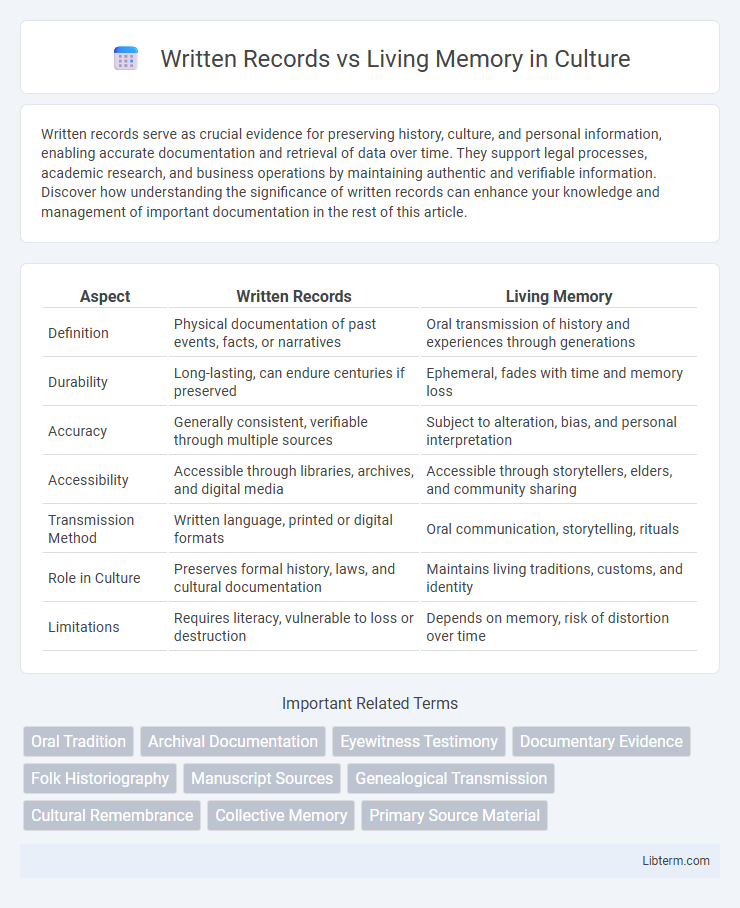Written records serve as crucial evidence for preserving history, culture, and personal information, enabling accurate documentation and retrieval of data over time. They support legal processes, academic research, and business operations by maintaining authentic and verifiable information. Discover how understanding the significance of written records can enhance your knowledge and management of important documentation in the rest of this article.
Table of Comparison
| Aspect | Written Records | Living Memory |
|---|---|---|
| Definition | Physical documentation of past events, facts, or narratives | Oral transmission of history and experiences through generations |
| Durability | Long-lasting, can endure centuries if preserved | Ephemeral, fades with time and memory loss |
| Accuracy | Generally consistent, verifiable through multiple sources | Subject to alteration, bias, and personal interpretation |
| Accessibility | Accessible through libraries, archives, and digital media | Accessible through storytellers, elders, and community sharing |
| Transmission Method | Written language, printed or digital formats | Oral communication, storytelling, rituals |
| Role in Culture | Preserves formal history, laws, and cultural documentation | Maintains living traditions, customs, and identity |
| Limitations | Requires literacy, vulnerable to loss or destruction | Depends on memory, risk of distortion over time |
Introduction: Defining Written Records and Living Memory
Written records consist of documented information preserved through texts, archives, and digital media, providing a tangible and searchable source of historical data. Living memory refers to the firsthand experiences and oral traditions transmitted directly by individuals or communities, often capturing emotional and cultural contexts absent in written documentation. Both forms serve as crucial repositories for preserving history, each offering unique insights into past events.
Historical Context of Documentation
Written records serve as tangible, enduring evidence of historical events, providing a structured and verifiable account that transcends generations. Living memory relies on personal testimonies and oral traditions, which capture emotional nuances and subjective experiences but may be altered by time and perspective. The historical context of documentation highlights the balance between preserving accurate facts through written archives and understanding cultural narratives maintained by collective memory.
Strengths of Written Records
Written records provide a permanent and verifiable source of information that preserves historical events with accuracy and detail unavailable in living memory. They enable systematic organization and easy retrieval of data, facilitating research and analysis across time. Unlike living memory, which may be affected by bias or fading recall, written documents maintain consistent and reliable accounts essential for legal, academic, and cultural purposes.
Limitations and Bias in Written Accounts
Written records often reflect the perspectives and biases of their authors, leading to selective representation of events and cultural viewpoints. The limitations in written accounts include omissions, exaggerations, and contextual misunderstandings influenced by the social and political environment of the time. Unlike living memory, which captures personal experiences and evolving narratives, written records may freeze interpretations, obscuring diverse or marginalized voices.
Power and Fragility of Living Memory
Living memory wields the power to convey emotions, cultural nuances, and personal perspectives that written records often lack, creating a dynamic and living connection to the past. Its fragility stems from susceptibility to distortion, loss, and selective recollection, making it vulnerable to fading over time. The interplay between these strengths and weaknesses highlights the unique role of oral traditions and eyewitness accounts in preserving history beyond static documentation.
Oral Traditions and Cultural Transmission
Oral traditions serve as vital channels for cultural transmission, preserving histories, beliefs, and customs through generations without written documentation. Despite their fluid nature, oral narratives adapt to social changes while maintaining core cultural identity, often enriching community cohesion. Unlike written records limited by static text, living memory in oral traditions enables dynamic interpretation and collective participation in historical preservation.
Comparing Reliability: Memory vs. Documentation
Written records offer a higher level of reliability compared to living memory due to their ability to provide consistent and verifiable information over time. Memory is prone to distortion, forgetting, and subjective interpretation, which can compromise accuracy, whereas documentation preserves facts, dates, and events objectively. In historical research and legal contexts, reliance on written records ensures greater precision and accountability than personal recollections.
The Role of Technology in Preserving Memory
Technology plays a crucial role in preserving memory by transforming written records into digital formats that ensure long-term accessibility and protection against physical decay. Advanced tools like cloud storage, blockchain, and artificial intelligence facilitate the organization, retrieval, and verification of historical data, enhancing the reliability of written records. Meanwhile, multimedia platforms and virtual reality enable the vivid preservation of living memory by capturing personal narratives and cultural experiences in dynamic, interactive forms.
Integrating Written and Oral Histories
Integrating written records and oral histories creates a comprehensive approach to preserving cultural heritage, allowing for cross-verification and richer contextual understanding. Written documents provide tangible evidence and chronological precision, while oral traditions offer personal insights and community perspectives often absent from formal archives. Combining these sources enhances historical accuracy and ensures diverse narratives are acknowledged in the collective memory.
Conclusion: Balancing the Two for Future Generations
Effective preservation of history requires balancing written records and living memory, as written documents provide accuracy and permanence while living memory ensures cultural context and emotional resonance. Institutions must leverage digital archiving technologies to safeguard written records and promote oral storytelling practices within communities to maintain dynamic historical continuity. Future generations benefit from this integrated approach, fostering a comprehensive understanding rooted in both empirical facts and human experience.
Written Records Infographic

 libterm.com
libterm.com